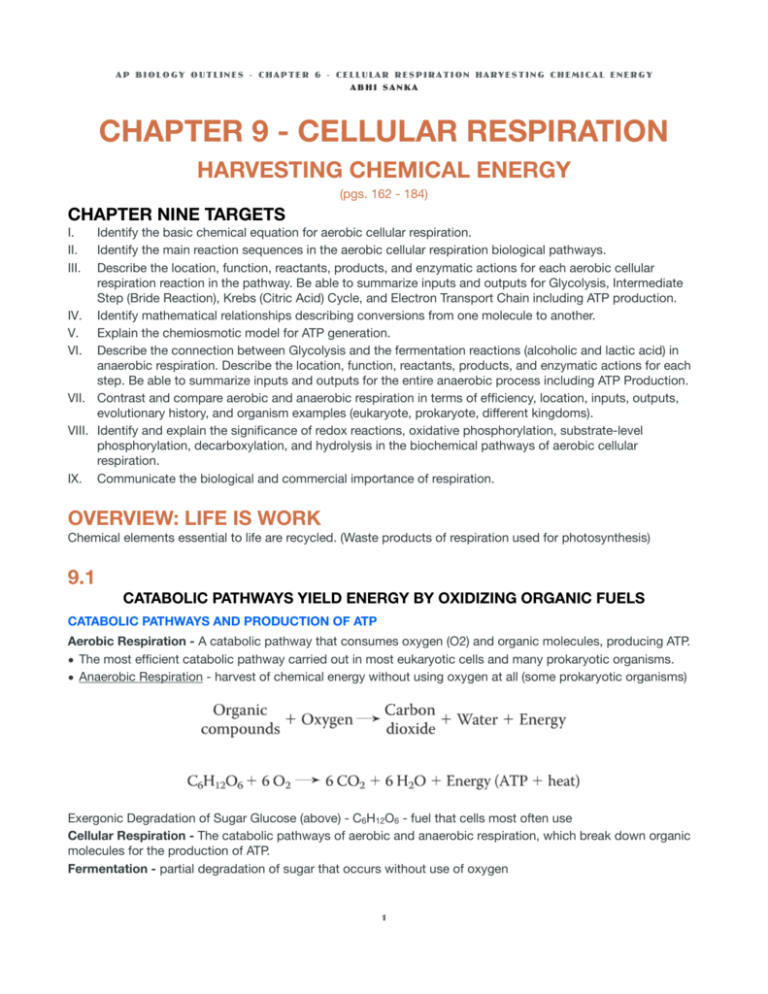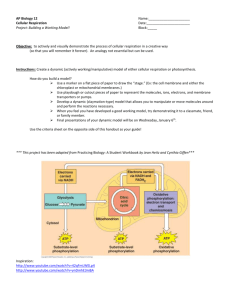AP Biology Outlines Chapter 9 - APBio10-11
advertisement

AP BIOLOGY OUTLINES - CHAPTER 6 - CELLULAR RESPIRATION HARVESTING CHEMICAL ENERGY ABHI SANKA CHAPTER 9 - CELLULAR RESPIRATION HARVESTING CHEMICAL ENERGY (pgs. 162 - 184) CHAPTER NINE TARGETS I. II. III. Identify the basic chemical equation for aerobic cellular respiration. Identify the main reaction sequences in the aerobic cellular respiration biological pathways. Describe the location, function, reactants, products, and enzymatic actions for each aerobic cellular respiration reaction in the pathway. Be able to summarize inputs and outputs for Glycolysis, Intermediate Step (Bride Reaction), Krebs (Citric Acid) Cycle, and Electron Transport Chain including ATP production. IV. Identify mathematical relationships describing conversions from one molecule to another. V. Explain the chemiosmotic model for ATP generation. VI. Describe the connection between Glycolysis and the fermentation reactions (alcoholic and lactic acid) in anaerobic respiration. Describe the location, function, reactants, products, and enzymatic actions for each step. Be able to summarize inputs and outputs for the entire anaerobic process including ATP Production. VII. Contrast and compare aerobic and anaerobic respiration in terms of efficiency, location, inputs, outputs, evolutionary history, and organism examples (eukaryote, prokaryote, different kingdoms). VIII. Identify and explain the significance of redox reactions, oxidative phosphorylation, substrate-level phosphorylation, decarboxylation, and hydrolysis in the biochemical pathways of aerobic cellular respiration. IX. Communicate the biological and commercial importance of respiration. OVERVIEW: LIFE IS WORK Chemical elements essential to life are recycled. (Waste products of respiration used for photosynthesis) 9.1 CATABOLIC PATHWAYS YIELD ENERGY BY OXIDIZING ORGANIC FUELS CATABOLIC PATHWAYS AND PRODUCTION OF ATP Aerobic Respiration - A catabolic pathway that consumes oxygen (O2) and organic molecules, producing ATP. • The most efficient catabolic pathway carried out in most eukaryotic cells and many prokaryotic organisms. • Anaerobic Respiration - harvest of chemical energy without using oxygen at all (some prokaryotic organisms) Exergonic Degradation of Sugar Glucose (above) - C6H12O6 - fuel that cells most often use Cellular Respiration - The catabolic pathways of aerobic and anaerobic respiration, which break down organic molecules for the production of ATP. Fermentation - partial degradation of sugar that occurs without use of oxygen 1 AP BIOLOGY OUTLINES - CHAPTER 6 - CELLULAR RESPIRATION HARVESTING CHEMICAL ENERGY ABHI SANKA REDOX REACTIONS: OXIDATION AND REDUCTION The relocation of electrons releases energy stored in organic molecules ultimately used to synthesize ATP Redox Reaction - A chemical reaction involving the complete or partial transfer of one or more electrons from one reactant to another; short for oxidationreduction reaction. • Oxidation - loss of electrons from one substance • Reduction - addition of electrons to another substance Reducing Agent - The electron donor in a redox reaction. (Xe-) [Reduces Y, which accepts electron] Oxidizing Agent - The electron acceptor in a recox reaction. (Y) [Oxidizes (Xe-) by removing an electron] • Not all redox reactions involve complete transfer of electrons (some change degree of electron sharing) Oxidation of Organic Fuel Molecules During Cellular Respiration • Glucose (fuel) is oxidized and oxygen is reduced. • Electrons lose potential energy, and energy is released. • Hydrogen abundant organic molecules excellent fuels (Hydrogen transferred above) • Main energy foods: carbohydrates/fats - reservoirs of electrons associated with hydrogen Stepwise Energy Harvest via NAD+ and the Electron Transport Chain NAD+ - Nicotinamide adenine dinucleotide: coenzyme that can accept an electron and acts as an electron carrier in the electron transport chain. (functions as an oxidizing agent during respiration) 2 • Most versatile electron acceptor in cellular respiration and functions in several redox steps during the breakdown of glucose AP BIOLOGY OUTLINES - CHAPTER 6 - CELLULAR RESPIRATION HARVESTING CHEMICAL ENERGY ABHI SANKA Electron Transport Chain - A sequence of electron carrier molecules (membrane proteins) that shuttle electrons during the redox reactions that release energy used to make ATP. • Means in which electrons that are extracted from glucose and stored as potential energy in NADH reach Oxygen • Consists of a number of molecules, mainly proteins, built into the inner membrane of mitochondria of eukaryotic cells and the plasma membrane of aerobically respiring prokaryotes • Electrons removed from glucose by NAD+ fall down an energy gradient in the electron transport chain to a far more stable location in the electronegative oxygen atom Summary of “Downhill Route”: glucose ➔ NADH ➔ electron transport chain ➔ oxygen. THE STAGES OF CELLULAR RESPIRATION: A PREVIEW 1. 2. 3. Glycolysis The Citric Acid Cycle Oxidative Phosphorylation: electron transport and chemiostasis 3 AP BIOLOGY OUTLINES - CHAPTER 6 - CELLULAR RESPIRATION HARVESTING CHEMICAL ENERGY ABHI SANKA First two stages of cellular respiration: Glycolysis and the citric acid cycle are the catabolic pathways that break down glucose and other organic fuels Glycolysis - The splitting of glucose into two compounds called pyruvate. (occurs in cytosol) • Occurs in almost all living cells, serving as the starting point for fermentation or cellular respiration. Citric Acid Cycle - the second major stage in cellular respiration involving eight steps that complete the metabolic breakdown of glucose molecules begun in glycolysis by oxidizing pyruvate to carbon dioxide • Carbon Dioxide represents fragments of oxidized organic molecules • Occurs within the mitochondrion in eukaryotic cells and in the cytosol of prokaryotes In third stage of respiration, the electron transport chain accepts electrons from the breakdown products of the first two stages and passes these electrons from one molecule to another. Oxidative Phosphorylation - the third major stage of cellular respiration; the production of ATP using energy derived from the redox reactions of an electron transport chain • Accounts for 90% of ATP generated in respiration (small amounts generated by glycolysis/citric acid cycle) • Stored in mitochondrion Substrate-level Phosphorylation - mode of ATP synthesis that occurs when an enzyme transfers a phosphate group from a substrate molecule to ADP, rather than adding an inorganic phosphate to ADP as in oxidative phosphorylation 4







